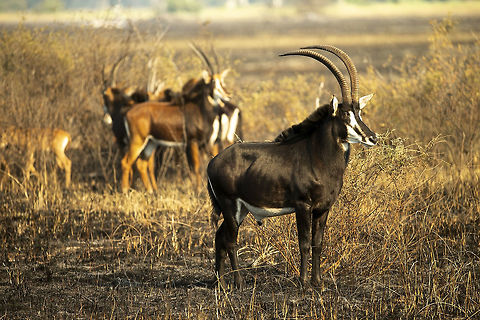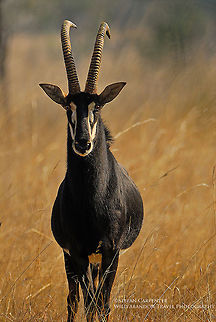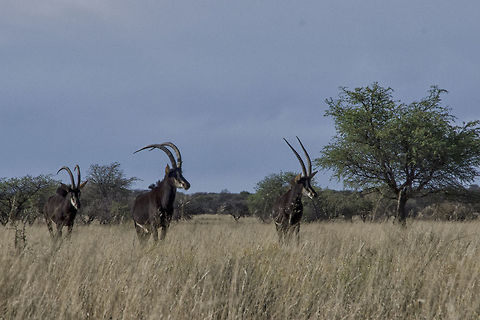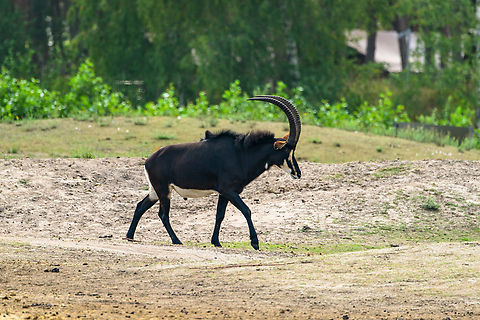
Appearance
The sable antelope is a large species. It ranges from 117 to 143 cm tall at the shoulder and measures 190 to 255 cm long, not counting a tail of 37–76 cm. Sable antelope can weigh from 150 to 270 kg. As its name implies, the giant sable antelope is slightly larger than other races, but it does not dwarf them. In all subspecies, males are slightly larger than females. Females are chestnut to dark brown, darkening as they mature, while males are very distinctively black. Both sexes have white underbellies, white cheeks and white chins. They have shaggy manes on the back of their necks. Sable antelope have ringed horns which arch backward, in females these can reach 1 m, but in males they can reach over 1.1 m. The lifespans of these animals is up to 18 years.
Naming
The four subspecies are:⤷ "H. n. niger", considered low-risk conservation dependent
⤷ "H. n. variani", the giant sable antelope of central Angola, classified as critically endangered
⤷ "H. n. kirkii", the Zambian sable antelope of central Angola and western Zambia, classified as vulnerable
⤷ "H. n. roosevelti", the Roosevelt sable antelope found in Kenya and Tanzania and possibly in Mozambique

Behavior
Sable antelope live in savanna woodlands and grasslands during the dry season, where they eat mid-length grasses and leaves. Sables will visit salt licks and have been known to chew bones to collect minerals. They are diurnal, but are less active during the heat of the day. Sable antelope form herds of 10 to 30 females and calves led by a single male, called a bull. Sable antelope males will fight among themselves; they drop to their knees and use their horns.In each herd, the juvenile males are exiled from the herd at about three years old. All of the female calves remain, however. When the herd gets too large, it divides into smaller groups of cows and their young. These groups will form new herds, once again with only one adult bull. The young males, which have been separated from the herd, associate in "bachelor groups" of up to 12 individuals. Among the bachelors, the most dominant will be the first individual to join a new group of females when the position is open. Very seldom, during their fights for dominance, are they able to inflict bodily harm to the contender.
When sable antelopes are threatened by a predator, including lions, they will confront it, using their scimitar-shaped horns. Many of these big cats have died during such fights. Despite their effectiveness, the sable's horns have contributed to the sharp decline of the animal, being a highly prized hunting trophy. In addition to heavy hunting, numbers have been reduced severely as part of regional tse-tse fly control programs.
The grassland habitat of the sable is being reduced due to habitat destruction for agricultural development. Antelope are important to their habitats as grazers and browsers. They are also important as prey for carnivores.

Habitat
Sable antelope live in savanna woodlands and grasslands during the dry season, where they eat mid-length grasses and leaves. Sables will visit salt licks and have been known to chew bones to collect minerals. They are diurnal, but are less active during the heat of the day. Sable antelope form herds of 10 to 30 females and calves led by a single male, called a bull. Sable antelope males will fight among themselves; they drop to their knees and use their horns.In each herd, the juvenile males are exiled from the herd at about three years old. All of the female calves remain, however. When the herd gets too large, it divides into smaller groups of cows and their young. These groups will form new herds, once again with only one adult bull. The young males, which have been separated from the herd, associate in "bachelor groups" of up to 12 individuals. Among the bachelors, the most dominant will be the first individual to join a new group of females when the position is open. Very seldom, during their fights for dominance, are they able to inflict bodily harm to the contender.
When sable antelopes are threatened by a predator, including lions, they will confront it, using their scimitar-shaped horns. Many of these big cats have died during such fights. Despite their effectiveness, the sable's horns have contributed to the sharp decline of the animal, being a highly prized hunting trophy. In addition to heavy hunting, numbers have been reduced severely as part of regional tse-tse fly control programs.
The grassland habitat of the sable is being reduced due to habitat destruction for agricultural development. Antelope are important to their habitats as grazers and browsers. They are also important as prey for carnivores.
References:
Some text fragments are auto parsed from Wikipedia.